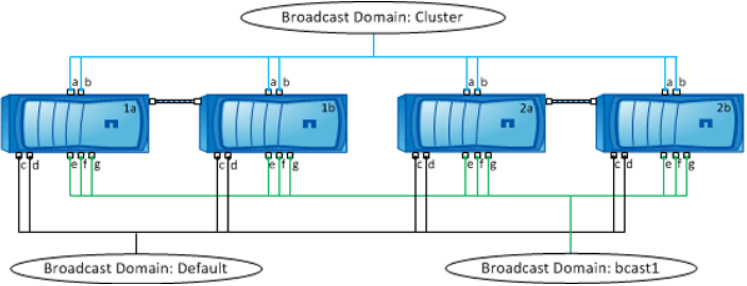
Broadcast domain overview (ONTAP 9.7 and earlier)
 Suggest changes
Suggest changes


-
 PDF of this doc site
PDF of this doc site
-
 Cluster administration
Cluster administration
-
 Volume administration
Volume administration
-
 Logical storage management with the CLI
Logical storage management with the CLI
-
-
 NAS storage management
NAS storage management
-
 Configure NFS with the CLI
Configure NFS with the CLI
-
 Manage NFS with the CLI
Manage NFS with the CLI
-
 Manage SMB with the CLI
Manage SMB with the CLI
-
 Manage file access using SMB
Manage file access using SMB
-
-
-
 Security and data encryption
Security and data encryption
-
 Data protection and disaster recovery
Data protection and disaster recovery
-
Collection of separate PDF docs
Creating your file...
Broadcast domains are intended to group network ports that belong to the same layer 2 network. The ports in the group can then be used by a storage virtual machine (SVM) for data or management traffic.
A broadcast domain resides in an IPspace. During cluster initialization, the system creates two default broadcast domains:
-
The Default broadcast domain contains ports that are in the Default IPspace.
These ports are used primarily to serve data. Cluster management and node management ports are also in this broadcast domain. -
The Cluster broadcast domain contains ports that are in the Cluster IPspace.
These ports are used for cluster communication and include all cluster ports from all nodes in the cluster.
If you have created unique IPspaces to separate client traffic, then you need to create a broadcast domain in each of those IPspaces.

|
Create a broadcast domain to group network ports in the cluster that belong to the same layer 2 network. The ports can then be used by SVMs. |
Example of using broadcast domains
A broadcast domain is a set of network ports in the same IPspace that also has layer 2 reachability to one another, typically including ports from many nodes in the cluster.
The illustration shows the ports assigned to three broadcast domains in a four-node cluster:
-
The Cluster broadcast domain is created automatically during cluster initialization, and it contains ports a and b from each node in the cluster.
-
The Default broadcast domain is also created automatically during cluster initialization, and it contains ports c and d from each node in the cluster.
-
The bcast1 broadcast domain has been created manually, and it contains ports e, f, and g from each node in the cluster.
This broadcast domain was created by the system administrator specifically for a new client to access data through a new SVM.

A failover group of the same name and with the same network ports as each of the broadcast domains is created automatically. This failover group is automatically managed by the system, meaning that as ports are added or removed from the broadcast domain, they are automatically added or removed from this failover group.



 Release notes
Release notes